Synthesis, characterization, and design of molecular materials, especially molecular conductors (including superconductors), have been undertaken. Molecular conductors exhibit a variety of physical properties which can be systematically understood on the basis of "simple" and "clear" electronic structures. From a chemical point of view, the most fascinating character of the molecular conductor is its "designability", that is, we can finely control solid state properties with chemical modifications of the molecule. The newly synthesized materials are characterized by the X-ray diffraction method and physical measurements (electrical conductivity...etc.). The electronic structure is investigated by the simple band structure calculation. All these results are devoted to the design of new molecular materials.
- Quantum spin liquid state in β'-Pd(dmit)2 salts
- Electronic states of molecular conductor (DI-DCNQI)2Cu under pressure
- Field effect measurement of molecular conductors on substrates
- Electrical properties of Mott insulators β'-(BEDT-TTF)2XCl2 (X=I, Au) under high quality hydrostatic pressure generated by diamond anvil cell
- Massless Dirac fermions in organic conductors
- First-principles study of hydrogen-bonding molecular conductors,κ-H3(Cat-EDT-TTF)2 and κ-H3(Cat-EDT-ST)2
- Universality class of the Mott transition from isothermal pressure sweeps measurements of the resistivity and thermoelectric effect in EtMe3P[Pd(dmit)2]2
(2) ESR of β'-EtMe3Sb[Pd(dmit)2]2
(3) NMR of cation sites in β'-EtMe3Sb[Pd(dmit)2]2
(2) Strain-tunable field-effect-transistor based on κ-(BEDT-TTF)2Cu[N(CN)2]Cl near the Mott transition
(3) Field effect in Pd(dmit)2 salts under hydrostatic pressure
(4) Improving carrier transport of organic Mott-FET using chemically functionalized substrate and metal-insulator transition
- Quantum spin liquid state in β'-Pd(dmit)2 salts
- Electronic states of molecular conductor (DI-DCNQI)2Cu under pressure
- Field effect measurement of molecular conductors on substrates
- Electrical properties of Mott insulators β'-(BEDT-TTF)2XCl2 (X=I, Au) under high quality hydrostatic pressure generated by diamond anvil cell
- Massless Dirac fermions in organic conductors
- First-principles study of hydrogen-bonding molecular conductors, κ-H3(Cat-EDT-TTF)2 and κ-H3(Cat-EDT-ST)2
- Universality class of the Mott transition from isothermal pressure sweeps measurements of the resistivity and thermoelectric effect in EtMe3P[Pd(dmit)2]2

The interplay between frustration and strong electronic correlations in quasi-two-dimensional molecular conductors with triangular lattices generates a wide range of exotic phases including spin liquid, valence bond solid, charge order, and unconventional superconductivity. The series of anion radical salts β'-X[Pd(dmit)2]2 (dmit = 1,3-dithiole-2-thione-4,5-dithiolate, X: closed-shell monovalent cations EtxMe4-xZ+, where x = 0-2 and Z = P, As, Sb) represents an important class of model systems for investigating quantum frustration. At ambient pressure, all these salts are Mott insulators and belong to a spin-1/2 system with antiferromagnetic Heisenberg interactions. The Pd(dmit)2 molecules in the β'-type crystal structure are strongly dimerized. Interdimer transfer integrals between the frontier molecular orbitals indicate that the dimer units form a quasi-triangular lattice within the anion layer and that spin frustration occurs. The ground states of these salts vary drastically depending on the choice of cation. The Me4Sb salt exhibits antiferromagnetic long-range order (AFLO). The Et2Me2Sb salt undergoes a charge order (CO) transition. The EtMe3Sb salt exhibits no indication of spin ordering/freezing down to 19.4 mK (less than 0.01% of the exchange coupling J) and there is strong evidence for a quantum spin liquid (QSL) ground state. Interdimer transfer integrals t and t' are key parameters in β'-X[Pd(dmit)2]2. The ground state is classified by the ratio tüL/t, which can be tuned by the choice of cation X (Figure 1). Tuning tüL/t from 0.6 (X = Me4P) to 1.0 (X = Et2Me2Sb), changes the ground state from AFLO to CO through QSL so that the QSL state of this system is situated between AFLO and CO. These three states compete around X = EtMe3Sb (t'/t = 0.9).
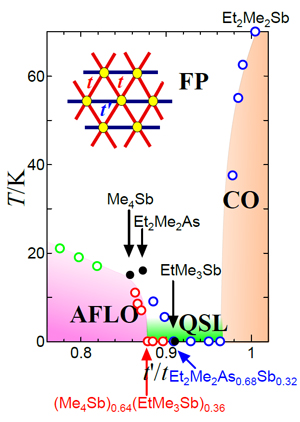
Figure 1: Phase diagram of β'-Pd(dmit)2 system where t and t' are interdimer transfer integrals. FP; Frustrated paramagnetic state, AFLO; Antiferromagnetic long-range ordered state, QSL; Quantum spin liquid, CO; Charge ordered state, üø; Me4Sb/EtMe3Sb mixed salts, üø; Et2Me2As/Sb mixed salts, üø; Me4As/Sb mixed salts.
(1) Physical properties of β'-Pd(dmit)2 mixed salts
Assign: Ueda, Cui, Iwase, Kato; S. Yamashita, H. Yamamoto, Tajima
This study seeks to fine tuning of t and t' by mixing cations. Increasing molar faction of relatively larger cation reduces the anisotropy of the triangular lattice, and the dimer units form an almost regular triangular lattice. The QSL phase with some width of t'/t in the Pd(dmit)2 salts was revealed by using three mixed crystal systems (Me4Sb(AFLO)-EtMe3Sb(QSL) salts, Me2Et2As(AFLO)-Et2Me2Sb(CO) salts, and Me4As(AFLO)-Me4Sb(AFLO) salts) until last year.
In the Me4Sb-EtMe3Sb and Et2Me2As-Et2Me2Sb mixed crystals, phase transition temperatures were suppressed rapidly, and the crystals whose t'/t values are close to that of the EtMe3Sb salt showed QSL-like behavior. The heat capacity measurements of them also indicated gapless excitations due to the QSL state in these mixed crystals, which suggests that presence of the QSL state is controlled by frustration tuning of a triangular lattice.
In the Me4As-Me4Sb mixed crystals, in which t'/t is small enough to provide AFLO, TN was proportional to the Me4As+ molar fraction. This behavior is in contrast to the boundary behavior of AFLO/QSL. This suggests that the presence of the QSL state in mixed crystals and strong suppression of transition temperature near QSL is not due to the disorder effect at cation sites, but is intrinsic nature of this frustrated spin system.
This year, to understand feature of the QSL phase, we studied magnetic behavior depending on t'/t, and discovered the following two special behaviors;
(a) Anomalous enhancement of free spin concentration. In all materials, a small amount of Curie-like paramagnetic contribution (free spin) is generally observed due to existence of chemical impunities and crystallographic defects. However, we discovered strange behavior of free spin concentration against t'/t in the [Pd(dmit)2] system. In the QSL crystals, including mixed crystals, the concentration of free spin was enhanced about 10 times larger than that in AFLO crystals, and remained almost constant in the whole QSL region. These enhanced and constant free spin concentrations are interesting, because some theoretical works pointed out the relation between free spin behavior and the presence of gapless QSL.
(b) Absence of magnetic anisotropy in Me4Sb salt (TN = 15 K). We studied the relation between magnetic anisotropy and t'/t. In the QSL crystal, namely EtMe3Sb salt, it was revealed that there was no magnetic anisotropic behavior down to 2 K. In any AFLO salts except Me4Sb salt, the magnetic susceptibilities perpendicular and parallel to the triangular lattice were split out below TN, and the easy axis of magnetization was decided to be perpendicular the triangular lattice. Though Me4Sb salt, which neighbors the QSL phase, obviously shows an AFLO transition behavior at 15 K, it did not show any magnetic anisotropy like EtMe3Sb salt. This result may suggest existence of a special magnetic state in the region between QSL and AFLO.
Transport measurements under pressure on mixed-crystals β'-Et2Me2As1-xSbx[Pd(dmit)2]2 have been performed to study the relation between superconductivity (SC) under pressure and the quantum spin liquid (QSL) state. The SC transitions have been found only in the salts with the antiferromagnetic ground state at ambient pressure. The empirical confirmation for the mixed crystals is required. In the salt with x= 0.9, whose ground state at ambient pressure is the charge order (CO), the TCO showed dome-like behavior in the pressure-temperature phase diagram. For the salt with x=0.75, we observed the change of the ground state from QSL to CO by applying pressure. The salts with x=0.1 and 0.2, on the other hand, showed a sharp reduction of the resistivity under ~8 kbar. The measurement of the magnetic field dependence of Tc confirmed that this behavior is attributed to the superconducting transition. However, the QSL material (x=0.50) has no signature of the superconducting transition.
(dmit = 1,3-dithiole-2-thione-4,5-dithiolate)
(2) ESR of β'-EtMe3Sb[Pd(dmit)2]2
Assign: Oshima, Kato
We have investigated the ESR behavior of β'-EtMe3Sb[Pd(dmit)2]2 to study the spin liquid state. Figure 1 shows the g-values for the in-plane direction at T = 5.0 K. A huge g-anisotropy was observed due to the d-orbital of the Pd, and the splitting of the ESR line was observed as well, where its origin is due to the two independent anion layers with different stacking directions. In general, if a non-negligible exchange interaction exists, the ESR lines from two independent layers merges to one ESR line due to the exchange narrowing. Therefore, our result strongly suggests that the interlayer coupling is infinitesimal.

Figure 1: The g-values of β'-EtMe3Sb[Pd(dmit)2]2 for the in-plane direction.
On the other hand, when the field is applied perpendicular to the triangular lattice, the g-value shifts in the same temperature region where a crossover behavior is observed from the specific heat measurements (Fig. 2). Usually, the g -shift and the linewidth broadening are observed when short-range order is observed, however, the linewidth did not show a distinct change. More detailed studies of the ESR behavior using high-frequency and low-temperature will be performed in the near future.
(dmit = 1,3-dithiole-2-thione-4,5-dithiolate)
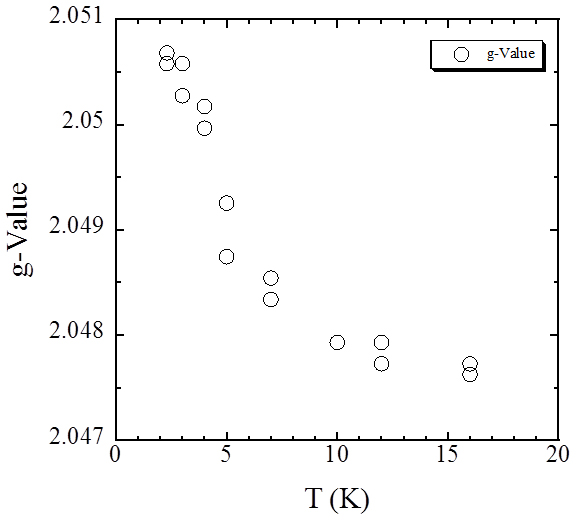
Figure 2: The temperature dependence of g-value for Bü█ab-plane of β'-EtMe3Sb[Pd(dmit)2]2.
(3) NMR of cation sites in β'-EtMe3Sb[Pd(dmit)2
Assign: Fujiyama, Kato
A recent finding of an anomaly in the lattice constant of β'-EtMe3Sb[Pd(dmit)2]2 at ~50K may be related to the quantum spin liquid state through the spin-lattice coupling. We measured nuclear spin-lattice relaxation rates (1/T1) of the proton sites of EtMe3Sb cation to explore the rotation of the cation. The 1/T1 of the protons of methyl- and ethyl-groups shows two broad maxima peaked at 40K and 180K, originating from the rotation of the groups. We also measured 1/T1's of D and H sites in β'-EtMe3Sb(d9) [Pd(dmit)2]2 of which proton sites of Me3 are replaced by deuterons. The 1/T1 at the D sites shows a maximum at 40K, while that at the H sites shows a strong enhancement at 180K. These results revealed that the broad maximum observed at 40K is ascribed to the rotation of the methyl groups, and the maximum at 180K is originating from the rotations of the ethyl group in the EtMe3Sb cation.
This argument is supported by another measurement of 1/T1 for β'-Me4Sb[Pd(dmit)2]2 of which ground state is an antiferromagnetic state with TN = 12K. The 1/T1 shows a broad maximum peaked at 40K. The series of experiments revealed that the rotation of methyl groups in the cation is a universal phenomenon in the [Pd(dmit)2] salts irrespective of their magnetic ground states.
(dmit = 1,3-dithiole-2-thione-4,5-dithiolate)
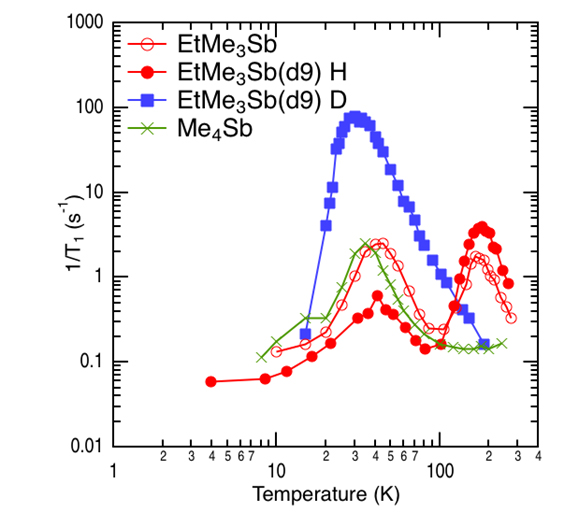
Assign: Cui, Tsumuraya, Kato; Miyazaki
Among the conducting Cu salts of a series of π-acceptors N,N'-dicyanobenzoquinonediimines (DCNQIs), (DI-DCNQI)2Cu exhibits very unique conducting behavior. The system is metallic down to the lowest temperature at ambient pressure. The resistivity measurements under pressure indicated that the low-temperature ground state changes as metal(I)→ Insulator(I)→metal(II) →insulator(II) →metal(III) with increasing pressure. This early work was performed using a clamp cell for the low pressure region and a cubic anvil cell for the high pressure region. The first principles DFT calculations proposed a possible two-fold lattice distortion in the insulating phase. The high-pressure X-ray diffraction measurements, however, revealed the three-fold lattice distortion that is frequently observed in the (DCNQI)2Cu system. In this work, we have reinvestigated resistivity under pressure up to 9.9 GPa using a diamond anvil cell (DAC) for all the pressure region. We also reexamined the band structure under high pressures with the first principles DFT calculations.
The DAC four-probe DC method was used for all measurements. The diamond culet size was 0.7 mm. Tension annealed SUS301 was used, and Daphne Oil 7373 was used as the pressure-transmitting medium. Electrical contacts were obtained by attaching four 10 m gold wires with gold paint. The pressure was determined by the shift of the ruby fluorescence R1 lines at room temperature. At ambient pressure (DI-DCNQI)2Cu is metallic. The resistivity at room temperature showed slight decrease with increasing pressure up to 1 GPa, and no pressure dependence in the higher pressure region. Above 1.15 GPa, the resistivity increased around 100K and decreased around 50K. At 1.5 GPa, however, the system turned to an insulator and did not return to a metallic state. The metal-to-insulator transition temperature shifted to higher temperatures (Tc was ~150 K at 2.26 GPa) with increasing pressure. At 2.7 GPa, a new metallic state appeared around 60K. In the pressure region of 3-9.5 GPa, the system remained metallic down to the lowest temperature.
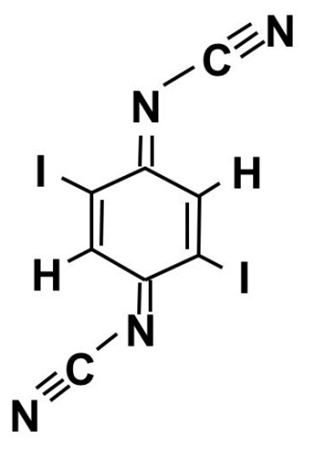 DI-DCNQI |
 Figure1 : The T-P Phase diagram of (DI-DCNQI)2Cu |
To understand the mechanism of the metal-insulator transitions under the pressure, we studied the electronic structure of molecular conductor with π-d orbital mixing system, (DI-DCNQI)2Cu under high pressure on the basis of first principles DFT calculations. In the present study, we used all-electron full-potential linearized augmented plane wave (FLAPW) method. The calculated band structures are fairly in good agreement with the previous first-principles results by ultrasoft pseudopotential method. Furthermore, we newly calculated Fermi surfaces to discuss their dimensionality and nesting vector. Figure 2 shows calculated band structures and Fermi surfaces. The findings are as follows:
1) At ambient pressure, bandwitdth of the DCNQI's LUMO bands is relatively narrow, and π-d hybridization is small compared with that in (DMe-DCNQI)2Cu salt, but it can be enhanced by applying pressure. ümFig.2 (a)ün
2) The HOMO-LUMO gap of an isolated DI-DCNQI molecule (~0.8eV) is smaller than that of DMe-DCNQI (~1.2eV). There is large contribution of Iodine-p state in the HOMO of the isolated DI-DCNQI molecule.
3) The LUMO bands cross the Fermi level at neither c*/3 nor c*/4. This is consistent with the experimental fact that the compound is metallic even at the lowest temperature. Under 15.3 kbar where it turns to be an insulator, the situation does not drastically change and the one-dimensional band cuts the Fermi level close at c*/2. On the other hand, the Cu dxy band shifts close to the Fermi level and the dxy-LUMO hybridization is enhanced.ümFig.2 (b), (e) ün
4) Under higher pressure of 37.61 kbar where the metallic state is observed in the whole temperatures region again (Metal ćU), the band structure is drastically changed; the three-dimensional Fermi surface in the metal(I) phase is supposed to disappear in the metal(II) phase, and the high pressure phase has only open (and distorted) Fermi surfaces; the HOMO bands become strongly dispersive and cross the Fermi level (1D Fermi surfaces around c*/10). This indicates that the LUMO, HOMO of DI-DCNQI and Cu-d states are strongly hybridized near Fermi level. ümFig.2 (c), (f)ün
(DI-DCNQI = 2,5-Diiodo-N,NüL-dicyanobenzoquinonediimine, DMe-DCNQI = 2,5-Dimethyl-N,NüL-dicyanobenzoquinonediimine)

(1) Field-induced superconductivity in an organic highly-correlated electron system
Assign: Kato; H. Yamamoto, Suda
κ-(BEDT-TTF)Cu[N(CN)2]Br (κ-Br) is an organic superconductor whose electronic state is Mott-insulating at room temperature but turns into metallic and even superconducting at low temperature through an increase of bandwidth upon thermal contraction. In our previous works, a tensile strain altered its ground state into a Mott-insulating state, when its thin (100-300 nm) crystal is laminated on top of SiO2/Si++ substrate and cooled down to low temperature. Although the electronic state at low temperature became completely insulating in this experiment because of the very small thermal expansion coefficient of Si substrate (2 ppm/K), one can anticipate from the T-P (temperature vs. pressure) phase diagram that mixed electronic state between superconducting and Mott-insulating states can be realized when the tensile strain is much weaker. To achieve such a mixed state (or, percolate-superconducting state) in the device, where phase-separation occurs between superconducting and Mott-insulating states, we have chosen Nb-doped SrTiO3 as a back-gate substrate because of its larger thermal expansion coefficient (ca. 10 ppm/K) than Si. An aluminum oxide layer was grown by atomic layer deposition technique to form a gate dielectric on the substrate. After lamination of κ-Br on the substrate, the Mott-FET device which showed a weakly insulating behavior at low temperature was fabricated. In this device, upon application of a positive gate voltage, the resistivity went down and weakly metallic behavior was observed at VG > 2 V. By further increasing the gate voltage up to 8 V, the device showed a sudden drop of resistivity around 5 K, which can be attributed to superconductivity. Taking into account of bistable IV characteristics observed in the low resistance region, the above transition can be understood as a percolation transition of superconducting islands that is induced by the electrostatic doping of electrons. The transition temperature increased as the gate voltage rose up and saturated at around VG = 11 V. The above result is the first example of field-induced superconductivity in organic materials, and can be utilized for uncovering a phase diagram of organic Mott system in the simultaneous control of band filling and band width.
(BEDT-TTF = bis(ethylenedithio)tetrathiafulvalene)
 |
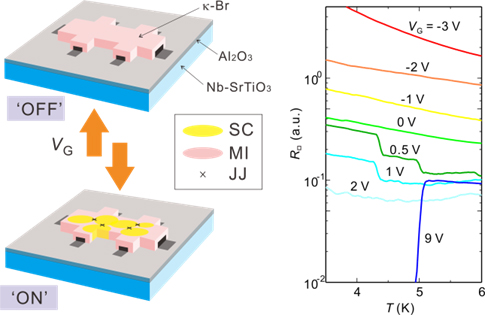 |
Figure: Schematic illustration for the FET device(left) and temperature dependency for the device resistance at various gate voltages (right).
(2) Strain-tunable field-effect-transistor based on κ-(BEDT-TTF)2Cu[N(CN)2]Cl near the Mott transition
Assign: Kawasugi, Kato; Suda, H. Yamamoto
κ-(BEDT-TTF)2Cu[N(CN)2]Cl(κ-Cl) is a strongly-correlated molecular conductor and the competition between the electron-electron Coulomb repulsion and the kinetic energy is highlighted, resulting in the pressure-induced bandwidth-controlled Mott transition. Recently, we have demonstrated an electric field-induced Mott transition in a thin-single crystal of κ-Cl. We report here the electrostatic carrier doping (ESD) into κ-Cl near the band-width-controlled Mott transition. We fabricated a single crystal FET of κ-Cl with a plastic substrate. The combination of ESD and strain effects induced by bending the substrate enables co-regulation of "bandwidth" and "band-filling" in κ-Cl. The κ-Cl on the substrate exhibited a superconducting behavior due to the positive pressure from the substrate. The κ-Cl showed a superconductor-to-insulator transition by applying the strain-effects (effectively negative pressure). Successively, we tried ESD into the κ-Cl under the strain. Interestingly, we found the field-effects also in the mixed state occurred during the Mott transition (Fig. 1). Remarkable device mobility, ca. 5900 cm2/Vs was obtained in this region although the ON/OFF ratio was only 1.1. Furthermore, this field-effect was almost suppressed by applying external magnetic field (7 T). This means that the superconducting fraction emerged by ESD into the insulating phase in the mixed state. This result suggests that the field-induced superconductivity will be possible by increasing the number of injected carriers.
(BEDT-TTF = bis(ethylenedithio)tetrathiafulvalene)
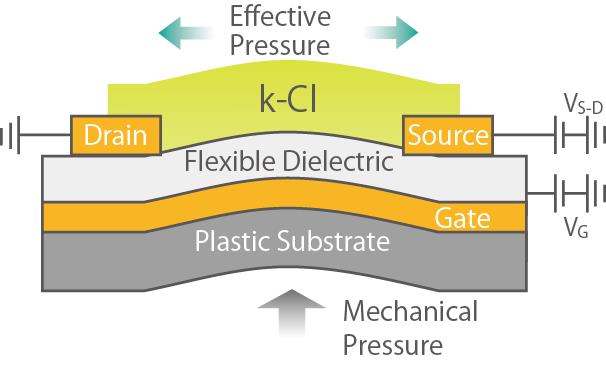

Figure: Schematic illustration for the FET device (left) and Field-effects in κ-(BEDT-TTF)2Cu[N(CN)2]Cl near the Mott transition (right).
(3) Field effect in Pd(dmit)2 salts under hydrostatic pressure
Assign: Kawasugi, Kato; Yamamoto
We developed a lamination method to fabricate field-effect transistors (FETs) based on molecular conductors, which enables electrostatic carrier doping into molecular conductors. We have currently achieved the electric-field-induced Mott transition and the superconducting transition in κ-type BEDT-TTF salts. To explore electric-field-induced phase transition in variety of molecular conductors, we measured field effect of β'-EtMe3Sb[Pd(dmit)2]2 under hydrostatic pressure. For the measurements under pressure, we employed flexible polymer substrates and insulating films not to damage the "soft" molecular-conductor channels.
β'-EtMe3Sb[Pd(dmit)2]2 is a Mott insulator and a quantum spin liquid candidate which exhibits insulator-metal transition at several kbar. While the FET samples showed n-type field effects at ambient pressure, anomalous hysteretic field effects appeared in the proximity of the insulator-metal transition under pressure. The history of the gate voltage was retained for at least a few hours. At the same time, the negative magnetoresistance and nonlinear current-voltage characteristics were observed, inferring that this anomalous field effect is related to some inhomogeneous nature of this system near the transition. Although the causal relation between this phenomenon and the quantum spin liquid state is still unclear, the behavior is different from the "conventional" anomalous field effect in disordered systems and is unique to this system at the moment.
(BEDT-TTF = bis(ethylenedithio)tetrathiafulvalene)
(dmit = 1,3-dithiole-2-thione-4,5-dithiolate)
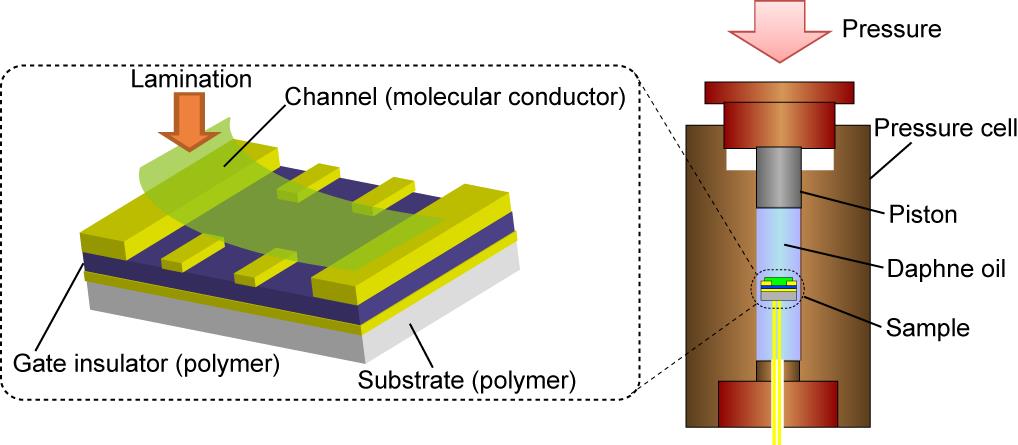

Figure: Schematic illustration for the FET device (left) and field effect in the proximity of the Mott transition of EtMe3Sb[Pd(dmit)2]2 (right)
(4) Improving carrier transport of organic Mott-FET using chemically functionalized substrate and metal-insulator transition
Assign: Sato, Kawasugi, Kato; Suda, H. Yamamoto
A molecular conductor κ-(BEDT-TTF)2Cu[N(CN)2]Cl (κ-Cl) is one of quasi-two-dimensional Mott insulator, in which, at low temperature, hole carriers are localized on each dimer of BEDT-TTF molecules due to strong on-site Coulomb interaction between carriers. Due to the fact that charge injection on Mott insulator can delocalize carriers, we have successfully realized filling-induced Mott transition by manufacturing FET channeled with single crystal of organic Mott insulators such as κ-Cl and its sister compound κ-Br. In such Mott-FETs, on the other hand, it is pointed out that carrier localization-delocalization transition is strongly affected by not only electron-electron correlation but also external randomness that stems from spatial potential fluctuation induced on the substrate surface, since it is generally in only a few conducting layers near the substrate interface that carrier concentration (i.e. band filling) is tuned in FETs.
The aim of this study is to elucidate the impact of the externally induced random potential on the phase transition in Mott-FET channeled with thin single crystal Mott-Insulator (κ-Cl). To modify substrate-surface potential, we applied chemically functionalized SiO2 substrate as a gate dielectric on which micrometer-sized pattern of organic self-assembled monolayer (SAM) is formed with alkylsilane (C8H17-terminated) or perfluoroalkylsilane (C6F13C2H4-terminated) molecules. The crystal thickness is in the range of several tens to several hundreds of nanometers. Remarkably, SAM functionalization greatly improved the device performance of κ-Cl Mott-FET; both of high on/off ratio (more than 106) and exceptionally high field-effect mobility (~200 cm2V-1s-1) were achieved in a single device. In addition, transition from insulating to metallic state is clearly observed in highly electron doped regime, which is missing for FETs with unfunctionalied SiO2 substrate. By an analysis of the activation energy of carrier transport in the insulating regime, we found localized carriers in Mott insulating phase more readily delocalize in the SAM-functionalized FET than in the unfunctionalized one. These results can be successfully explained by assuming that the SAM serves as spacer layer which suppresses the spatial potential fluctuation generated by e.g. charged impurities embedded in SiO2 substrate. Intriguingly, metallic-insulating transition on SAM-functionalized FETs occurs at the conductivity of σü`1.5 e^2/h (e: elementary charge, h: Planck constant), corresponding to Ioffe-Regel limit in two-dimensional metals. Further work is under way to explore the critical behavior in close proximity to metal-insulator transition.
(BEDT-TTF = bis(ethylenedithio)tetrathiafulvalene)
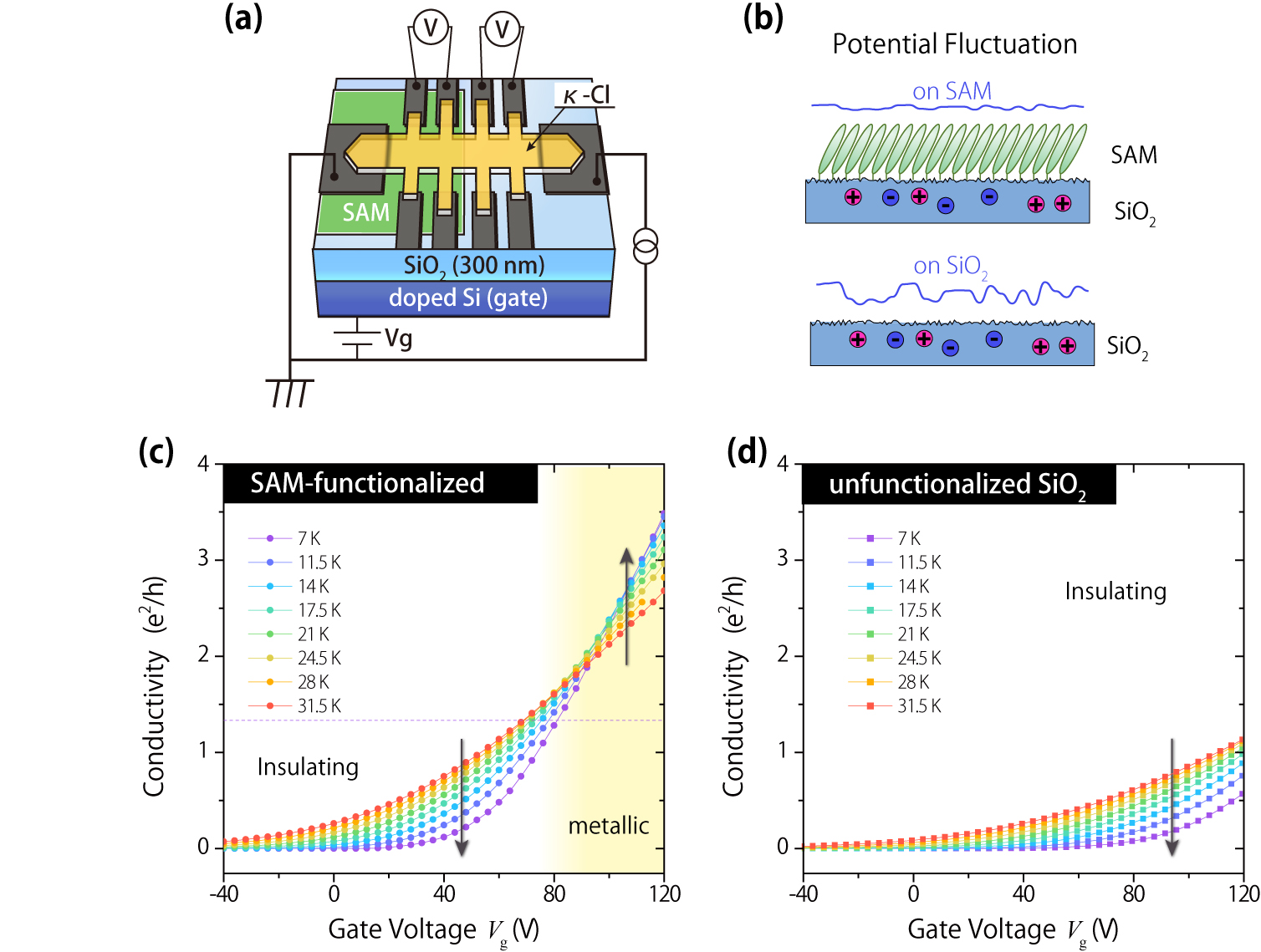
Assign: Cui, Iwase, Kato; Bangura
To gain understanding of physical properties under extremely high pressure, the quality of high pressure environment plays a critical role. Due to the limitation of the strength of materials used in high pressure equipment, most measurements are performed only below 10 GPa. Measurements with pressures higher than 10 GPa require the use of diamond anvil cell (DAC) technology, which has been thought to be limited in terms of the hydrostaticity. Organic conductors β'-(BEDT-TTF)2XCl2 (X=I, Au) are Mott insulators at ambient pressure. At 8.2 GPa, the ICl2 salt becomes superconducting at 14.2 K, which is the highest superconducting transition temperature in organic conductors up to date. However, for the isostructural β'-(BEDT-TTF)2AuCl2, the metallic state was not observed up to 9.9 GPa. Here we measured high pressure electrical resistivity for β'-(BEDT-TTF)2XCl2 (X=I, Au) up to 14 GPa by using DAC. Comparing DAC results with those obtained by the cubic anvil cell (CAC) measurements, we found that our four-probe DAC technique can provide high quality hydrostatic pressure over 10 GPa. The diamond anvils with culet diameter of 0.7 mm were used in combination with gaskets made of tension annealed stainless steel SUS301. Daphne oil 7373 was used as a pressure transmitting medium. The 10 m gold wires were attached sample with gold paint to make four contacts and a thin layer of Al2O3-reinforced epoxy was used to encapsulate the sample. We confirmed that β'-(BEDT-TTF)2ICl2 in DAC turned superconducting at 10.1 GPa and 13.8 K. We also found a clear metallic state in β'-(BEDT-TTF)2AuCl2 at 12.9 GPa, and an abrupt drop of resistivity at 30K.
(BEDT-TTF = bis(ethylenedithio)tetrathiafulvalene)

Figure: (a) BEDT-TTF molecular (b) crystal structure of β'-(BEDT-TTF)2XCl2 (X=I, Au) (c) a sample at 14.1 GPa assembled in a DAC
Assign: Kawasugi, Kato; Tajima, Suda, H. Yamamoto
We have discovered two-dimensional (2D) massless Dirac fermions system in organic conductor α-(BEDT-TTF)2I3 under high pressures. This material with layered structure and tilted Dirac cones belongs to a broader category of 2D massless Dirac fermion system. Thus, this material provides us with a testing ground for the transport of the multilayered massless Dirac fermion systems.
In the Dirac fermion system, the relativistic Landau level is the most important characteristic feature. When the magnetic field is applied perpendicular to 2D plane, N = 0 Landau level called zero-mode always appears at the zero-energy (Dirac point). We have succeeded in detecting the zero-mode carriers including spin splitting on the transport.
Recently, Osada pointed out that ν = 0 quantum Hall ferromagnetism state is realized in this spin-splitting state at low temperature and high magnetic field. In this situation, the interaction between layers plays an important role in the spin textures. In this work, we experimentally demonstrated that the interaction between layers gave rise to peculiar spin splitting of zero-mode carriers. The effective g-factor estimated from the transport measurements abruptly drops from 2 below 2 K. Moreover, this effect also yields the peculiar spin splitting of other Landau levels. Each spin splitting for N = -1 and -2 Landau levels was examined from the detection of SdH oscillations using PEN (polyethylene naphthalate) substrate device. In this device, holes are injected into the first layer mainly from the interface. Thus, we can examine the effects of the interaction between layers which are in spin-splitting states of the zero-mode and other Landau levels on the quantum transport phenomena. We verified that both of the effective g-factors estimated from the spin splitting of N = -1 and -2 Landau levels are much smaller than 2.

Figure 1: Temperature dependence of effective g-factor estimated from spin-splitting of Landau levels.
Assign: Tsumuraya, Kato; Seo, Miyazaki
We theoretically studied a new class of molecular conductors with hydrogen bonding that have been synthesized recently, by means of first-principles band calculations. The materials are based on catechol with ethylenedithiote-tetrathiafulvalene (Cat-EDT-TTF) and its diselena analog (Cat-EDT-ST). Among them, κ-type H3(Cat-EDT-TTF)2 is considered to be a Mott insulator at ambient pressure and emerges as a candidate of realizing quantum spin liquid state. κ-H3(Cat-EDT-ST)2 also shows insulating behavior, and turns into a metal under the pressure of 2.2 GPa, where the electric conductivity increases up to 180 S/ cm; κ-H3(Cat-EDT-TTF)2 remains insulating up to about 1.6 GPa. In their crystal structures, two H(Cat-EDT-TTF/ST) units share a H atom with a short O-H-O hydrogen bond, and face-to-face dimers form an anisotropic triangular lattice. Differently from conventional two-dimensional (2D) cation radical salts, these compounds do not have insulating anion layers.
In this study, the structural properties and electronic structures are investigated by first-principles calculations based on the density functional theory (DFT). To discuss anisotropy of the triangular lattice and estimate interlayer interactions, we obtained interdimer transfer integrals by performing tight-binding fitting to the DFT band structures. The band structure near the Fermi level shows a quasi-2D character similar to the known dimer-Mott insulator κ-(BEDT-TTF)2X, and their effective dimer-dimer interactions indicate a quasi-one-dimensional (1D) anisotropy with frustrated inter-chain couplings. We also found rather large interlayer dispersion due to the absence of insulating anion layers. Lastly, adiabatic potential energies for the shared H were calculated, and a symmetric shallow well potential was obtained. This indicates that the hydrogen's wavefunction is spread in over the two wells, which postulates that the shared H atom can move freely between two O atoms.

Figure 1: (a) Molecular structure of H3(Cat-EDT-TTF)2
(b) Crystal structure of κ-H3(Cat-EDT-TTF)2
(c) Longitudinal view along the a-axis showing bc-plane. The inter-dimer transfer integrals are presented.
Assign: Abdel Jawad, Kato; Tajima, Watanabe, Ishii
A first-order phase transition ends at a critical endpoint where critical fluctuations are large and dominate the behaviour of physical quantities. It is believed that such behaviors are universal and depend only on 3 parameters. Currently, the universality class of the Mott transition is an unresolved problem. To help resolve this issue, we have measured the isothermal pressure, P measurements of the conductivity, σ and the thermoelectric effect within a Helium pressure medium in EtMe3P[Pd(dmit)2]2, a dimer-Mott insulator. The Seebeck coefficient, SB is of particular interest as the Mott-transition is clearly seen in this compound (Fig. 1) and helps us to determine the critical pressures of the metallic state in a clear and objective way. Surprisingly, it is found that the metal-insulator limit above the critical end-point is not, as assumed in previous studies, at the maximum of ∂σT(P)/∂P. Scaling of the conductivity and the Seebeck coefficient, on both the insulating and the metal sides, show values of the critical exponents that fall within the Ising universality.

Figure 1: Isothermal pressure dependence of the Seebeck coefficient in EtMe3P[Pd(dmit)2]2 at temperatures ranging from 22 K, up to 60 K.












